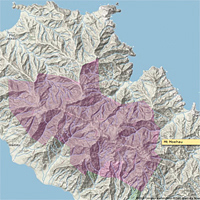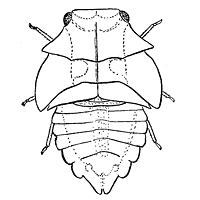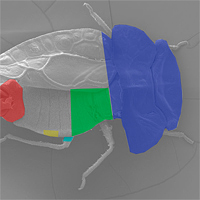























Knowledge management in natural science collections and community building
Given that many researchers work with visual information that is difficult to verbalise, the HyperTaxon project aimed at exploring novel opportunities presented by the comparative image processing developed by HyperImage for systematic zoological research. Of the numerous ideas suggested for the application – some of which have yet to be implemented – the HyperTaxon (the ‘moss bug’) project is the once that has progressed the most.
The project was dedicated to the systematic and innovative representation of information on the Peloridiidae, an enigmatic group of insects (from the suborder of Hemiptera, which includes cicada, aphids and bugs, as well as other economically significant species). This group is relatively small (comprising only 25 recorded species) but are of importance in the system of the Hemiptera. They are generally small (mostly 2-3mm) and live cryptically in moss, which partially explains why they have been so sparingly researched. The project pursued two key aims. Firstly, its aim was to compile most of the existing information on the group, with particular attention paid to graphic and acoustic, i.e. non-verbal, information. We should explain that much of the data was only gathered in our working group (AG Hoch, at the Museum für Naturkunde, Berlin) and partially not yet appropriately published in journals. The intention was to make all this new and old information easily accessible to academics and interested laypeople, thereby stimulating research on the group.
Secondly, HyperImage tools provide users with many options in their work with the data: not only can they passively internalise the data, they can also compare and combine the data using a variety of criteria, thereby possibly uncovering new laws of nature. Thus, HyperImage can become a novel tool in biological systematics that could make this science truly interactive.
Even during the preparatory work on the project, it was possible to identify a range of possibilities the program opened up for taxonomic work. As HyperImage primarily works with visual information some of the items that were only available in verbal form had to be converted to graphics. This novel form of presentation, together with an array options to group and combine graphic information have produced unexpected insights into the taxonomy of groups, even at this early stage. After we had compiled the distribution maps for the New Zealand species, we were able to identify, for the first time, the fact that the majority of these species is only represented by one or two finds and that these are always sympatric (i.e. in the same region), and at least with one other species. This fact raises question on the evolution of the group, as well as on the taxonomic status of individual species – questions which had not been raised at all in the past. Another thought-provoking example is the opportunity to compile all existing images of a species gathered from a wide-ranging publications for the first time, using simple technical methods, and to research these in connection with information on distribution, morphology, etc. We are optimistic that this will lead new awareness in respect of morphological variations. If this is just the beginning, we are also hopeful that final results will lead to a new understanding on this interesting group of insects.
Project Director: Prof. Dr. Hannelore Hoch
Museum für Naturkunde,
Humboldt University, Berlin, Institute for Systematic Zoology
Invalidenstraße 43, D - 10115 Berlin
Phone +49 (0)30 2093 8519 | Fax +49 (0)30 2093 8528
hannelore.hoch@museum.hu-berlin.de
Contents: Viktor Hartung